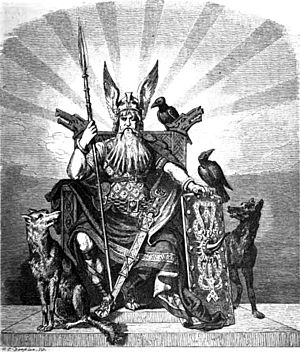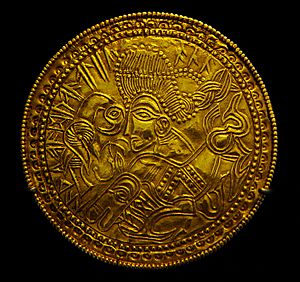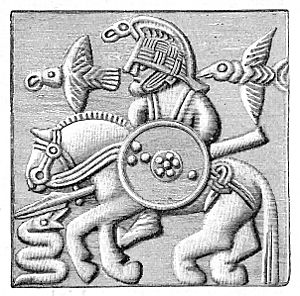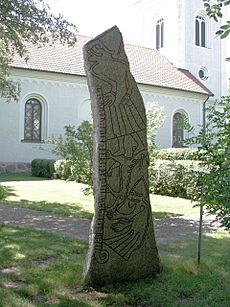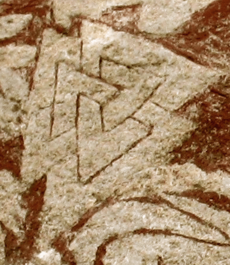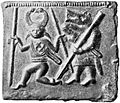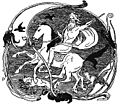Odin facts for kids
Odin is a very important god in Norse mythology. He is known for wisdom, poetry, death, and magic. Odin is the son of Bor and the giantess Bestla. He is the leader of the Æsir gods and the king of Asgard, their home.
Odin is married to the goddess Frigg. He is the father of many gods, including Thor, Baldr, Höðr, Víðarr, and Váli.
People often call Odin the All-Father. He is usually seen with two ravens, Huginn and Muninn, and two wolves, Geri and Freki. Odin rides an amazing eight-legged horse named Sleipnir. He carries a powerful spear called Gungnir, which was made by dwarves and always hits its target.
A special thing about Odin is that he has only one eye. He gave up one of his eyes to drink from the Well of Urðr. This gave him incredible knowledge about the universe.
When warriors die in battle, half of their souls are guided by the Valkyries to Valhalla. This is Odin's huge and beautiful hall. The other half go to Fólkvangr, which is the realm of the goddess Freyja.
The English weekday name Wednesday comes from Odin's name. It means "Wōden's day" (Wōden is another name for Odin).
Contents
Odin's Family and Children
Odin's parents are Borr and the giantess Bestla. His wife is the goddess Frigg. With Frigg, he is the father of the twin gods Baldr and Höðr.
Odin also has other sons with different giantesses. With Gríðr and Rindr, he is the father of Víðarr and Váli. His oldest son is Thor, the god of thunder. Thor's mother is Jörð, who represents the Earth.
Odin in Ancient Discoveries
Archaeologists have found many old objects that show Odin or refer to him. These discoveries help us understand how people in the past thought about this god.
Gold Bracteates and Helmet Plates
During the Migration period (around 400-600 CE), people made small gold pieces called bracteates. Many of these show a human figure riding a horse, holding a spear, and with one or two birds nearby. Experts believe this figure is Odin, and the birds are his ravens, Huginn and Muninn. Sometimes, a bird is shown near the ear of the person or the horse. These bracteates have been found in places like Denmark, Sweden, and Norway.
Some experts think these pictures might show Odin and his ravens healing a horse. This suggests that the ravens were not just his battle companions, but also helped him with healing animals.
Helmet plates from the Vendel Period (around 500-700 CE) found in Sweden also show a helmeted figure on a horse, with a spear and shield, and two birds. This is also thought to be Odin with his ravens.
Image Stones and Runes
Two large picture stones from the 8th century on the island of Gotland, Sweden, show horses with eight legs. Most scholars believe these horses are Sleipnir, Odin's special steed. The Tjängvide image stone and the Ardre VIII image stone both feature a rider on an eight-legged horse. Some scholars think this rider is Odin.
On the Tjängvide stone, there is also a figure holding a spear above the rider, which might be a valkyrie. A female figure offers the rider a cup. This scene could show a rider arriving in the world of the dead. The Eggja stone from the mid-7th century has a runic inscription that includes the name haras, meaning 'army god', which is linked to Odin. It might also show Sleipnir.
Bird-Shaped Brooches
A pair of matching bird-shaped brooches from the Germanic Iron Age were found in Denmark. They are thought to show Huginn and Muninn. The birds have strong beaks and fan-shaped tails, which look like ravens. They were worn on each shoulder, which makes people think of Odin's ravens. The archaeologist Peter Vang Petersen suggests that the masks on the ravens might even be portraits of Odin, as Odin is known for disguises.
Oseberg Tapestry and Ribe Moulds
The Oseberg tapestry fragments, found in a Viking Age ship burial in Norway, show two black birds flying over a horse. These birds are believed to be Huginn and Muninn.
In Ribe, Denmark, archaeologists found a metal mould from the Viking Age. It shows a man with a mustache wearing a helmet with two ornaments on it. These ornaments are thought to be Huginn and Muninn, meaning the man is Odin. Similar pictures have been found in many places where Vikings traveled.
Thorwald's Cross and Ledberg Stone
A part of Thorwald's Cross on the Isle of Man shows a bearded man holding a spear, with his foot in the mouth of a wolf. A large bird is on his shoulder. This bird could be Huginn or Muninn. This scene is often seen as Odin being eaten by the monstrous wolf Fenrir during the end of the world, known as Ragnarök.
The 11th-century Ledberg stone in Sweden also shows a figure with his foot in the mouth of a four-legged beast. This might also be Odin being eaten by Fenrir at Ragnarök.
Odin from Lejre Figurine
In 2009, a silver figurine called Odin from Lejre was found in Denmark. It shows a person sitting on a throne with animal heads, and two birds on either side. The museum believes this is Odin sitting on his throne Hliðskjálf, with his ravens Huginn and Muninn.
The Valknut Symbol
The valknut is a symbol found on many old objects. Some scholars think it is connected to Odin. For example, it appears next to Odin on some memorial stones. It is believed to show Odin's power to "bind and unbind" minds. This means Odin could make men helpless in battle or give them great courage and inspiration. Similar symbols are also found with wolves and ravens on old cremation urns.
Related pages
- Saturn - A Roman god similar to Odin
- Kronos - A Greek god similar to Odin
- Shiva - A Hindu god similar to Odin
Images for kids
-
Wodan and Frea look down from their window in the heavens to the Winnili women in an illustration by Emil Doepler, 1905
-
A 16th-century depiction of Norse gods by Olaus Magnus: from left to right, Frigg, Odin, and Thor
-
Odin sits atop his steed Sleipnir, his ravens Huginn and Muninn and wolves Geri and Freki nearby (1895) by Lorenz Frølich
See also
 In Spanish: Odín para niños
In Spanish: Odín para niños


